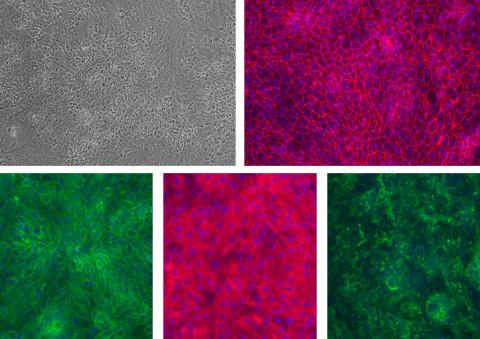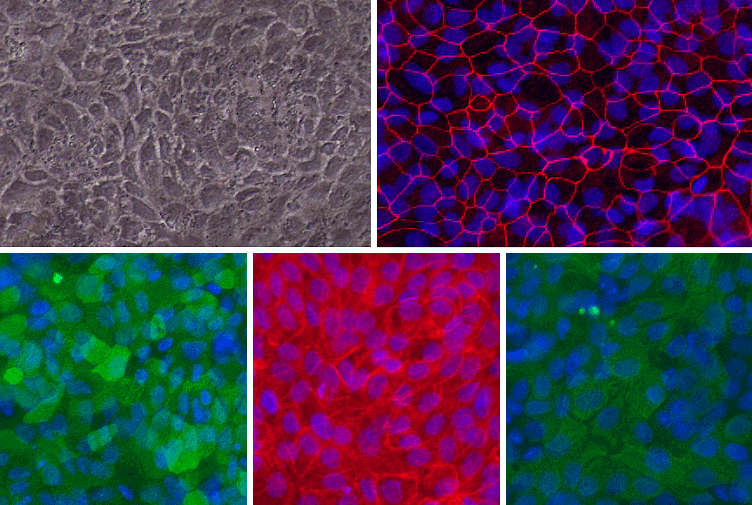Human Gastric Epithelial Cells: HGaEpC 人胃上皮細胞:HGaEpC
產品型號: 732GaK-10a
NOW AVAILABLE: ADULT HUMAN GASTRIC EPITHELIAL CELLS

Adult HGaEpC Monolayer. Top left: Phase contrast; Top right(red): ZO-1; Bottom left (green): Na+K+ ATPase; Bottom middle (red): pan-Cytokeratin; Bottom right (green): Villin; Blue: DAPI
The gastric mucosa is the mucous membrane layer of the stomach lumenwhich contains the glands and the gastric pits. The human stomach lumen is lined with a monolayer of epithelial cells. The epithelium constantly renews itself and the stem cells fueling this process reside in the gastric glands. An important function of the gastrointestinal epithelium is to protect from infections, and support a peaceful co-existence with gut microbiota. The gastric pathogen Helicobacter pylori is one of the most common pathogens to colonize the stomach, and chronic infection can lead to gastric ulcers, gastritis, and gastric cancer. Primary human gastric epithelial cells would represent the gastric epithelium closely, but until now no primary gastric culture system exists that enables effective research of gastric diseases and disorders in vitro.
CAI provides a gastric epithelial culture system that results in a gastric epithelial cell monolayer with tight junction that is stable for up to a week in culture. Our system enables investigation of gastric epithelial cell physiology and their response to infection, tight junction function, as well as testing of multiple therapeutic agents for gastrointestinal research.
With optimized, defined culture media from CAI, the Gastric Epithelial Cells can be seeded and maintained for as long as 8 days. Epithelial Cells grown in CAI medium form a monolayer of polarized epithelial cells with tight junction formation as evidenced by Villin (apical marker), Na+/K+ ATPase (basolateral marker), ZO-1 (tight junction marker) and pan-Cytokeratin (epithelial marker) staining.
DETAILS
| Tissue | Normal healthy human stomach. |
| QC | No bacteria, yeast, fungi, mycoplasma, virus. |
| Bioassay | Attach, spread, in Culture Medium. |
| Cryovial | 500,000 or 1,000,000 HGaEpC in Freezing Medium. |
| Kit | Cryovial frozen HGaEpC (732Ga-20f), Culture Med (716DC-50), Coating Solution (025-05), Thawing Solution (716T-20). |
| Cultured | Shipped in flasks or plates in medium. |
| Doublings | Cells do not divide and cannot be passaged. |
| Applications | Laboratory research use only (RUO). Not for human, clinical, diagnostic or veterinary use. |
PRODUCTS
| PRODUCT | SIZE | CAT.# |
| Cryopreserved HGaEpC, Adult: 1x10^6 Cells (adult), Culture Medium, Coating and Thawing Solution (See Details tab for specifics) | 1 Kit | 732GaK-10a |
| Cryopreserved HGaEpC, adult: Frozen HGaEpC (1x10^6) | 1 Cryovial | 732Ga-10a |
| Cryopreserved HGaEpC, Adult: 5x10^5 Cells (adult), Culture Medium, Coating and Thawing Solution (See Details tab for specifics) | 1 Kit | 732GaK-05a |
| Cryopreserved HGaEpC, adult: Frozen HGaEpC (5x10^5) | 1 Cryovial | 732Ga-05a |
| Cryopreserved HGaEpC, Fetal: 1x10^6 Cells (fetal), Culture Medium, Coating and Thawing Solution (See Details tab for specifics) | 1 Kit | 732GaK-10f |
| Cryopreserved HGaEpC, fetal: Frozen HGaEpC (1x10^6) | 1 Cryovial | 732Ga-10f |
| Cryopreserved HGaEpC, Fetal: 5x10^5 Cells (fetal), Culture Medium, Coating and Thawing Solution (See Details tab for specifics) | 1 Kit | 732GaK-05f |
| Cryopreserved HGaEpC, fetal: Frozen HGaEpC (5x10^5) | 1 Cryovial | 732Ga-05f |
RELATED PRODUCTS
| PRODUCT | SIZE | CAT.# |
| GI Epithelial Cell Defined Culture Medium: All-in-one medium, includes antibiotics. Store at -20C. Once thawed, store at 4C and use within 4 weeks. | 50 ml | 716DC-50 |
| GI Epithelial Cell Coating Solution: Coating solution for GI Epithelial Cells | 5 ml | 025-05 |
| GI Epithelial Cell Thawing Solution: Thawing solution for GI Epithelial Cells | 20 ml | 716T-20 |
EXTENDED FAMILY PRODUCTS
| PRODUCT | SIZE | CAT.# |
| TEER Assay GI Epithelial Cell Medium : All-in-one ready-to-use optimized media for studying GI epithelial barrier function. Store at -20C. Once thawed, store at 4C and use within 4 weeks. | 50 ml | 716TA-50 |



